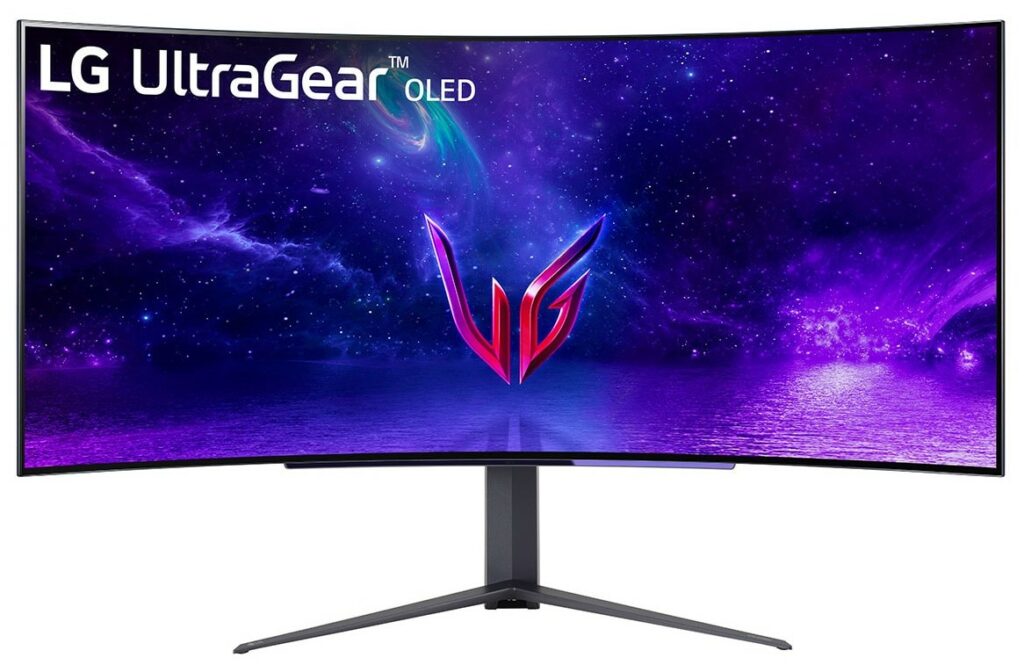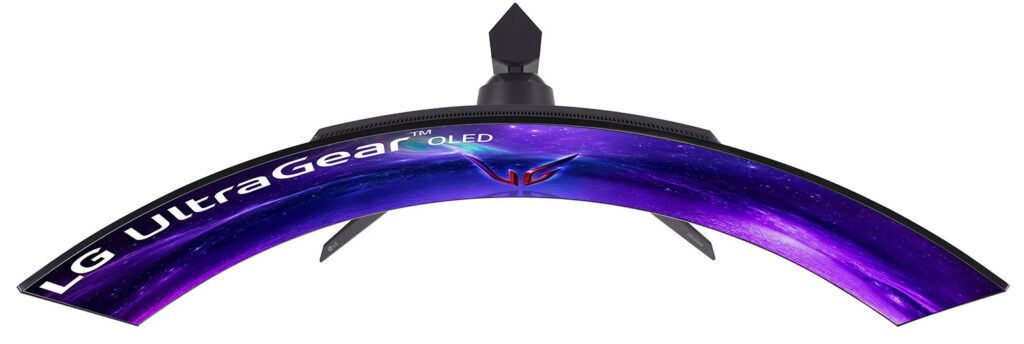The LG 45GR95QE-B stands out against its competition with its massive 45-inch QD OLED panel. It’s capable of stunning HDR imagery, but it’s also lightning fast, like the smaller 27GR95QE-B. However, it costs a pretty penny like most OLED displays so it deserves a deeper look before recommendation.
LG 45GR95QE-B Specifications
- Screen Size: 45 Inches
- Resolution: 3440 x 1440 UWQHD
- Aspect Ratio: 21:9
- Panel Technology: OLED
- Refresh Rate: 240Hz
- Response Time: 0.03ms
- Contrast Ratio: 150000:1
- Brightness: 200 cd/m2 (1000 cd/m2 Peak)
- Built-in Speakers: None
- Stand: Height – No
- Stand: Tilt – Yes
- Stand: Swivel – No
- Stand: Pivot– No
- VESA Compatibility: None
- Connectivity: DisplayPort 1.4 DSC x 1, HDMI 2.1 x 2, USB-C PD90W x 1, USB 3.0 x 4, 3.5mm Jack x 1
- Dimensions: 39.1” x 25.5” x 14.3”
- Weight: 24.03
Design and Features
The LG 45GR95QE-B boasts the new and more mature UltraGear aesthetic, which looks cleaner and more sophisticated. It has a matte black aesthetic with purple accents, plus some RGB lighting at the back for bias lighting and setup themes. The display is bezel-free, but it still has inner borders that are barely noticeable.
It’s a massive monitor, so you have to prepare your desk since it will surely offset your other large peripherals. It is 40 inches wide and more than 14 inches deep, so it smaller desks will not be able to hold it. It’s not terribly heavy at 24.03 pounds, but it’s easy to get off-balanced while carrying it because of its size and unnatural curve.
It’s a true-blue premium monitor, so don’t expect anything less when it comes to build quality. The monitor feels refined and durable, and there were no cosmetic defects on any of its parts. The included stand is firm and stable, despite the screen size.
The LG 45GR95QE-B has no traditional joystick or button layout for its OSD. What it does have is a full-sized remote that’s easier to use since you hold it in your hand rather than reach for it blindly. The monitor’s only button is its power switch, but you can use the remote for that as well.
The stand included with the package offers tilt, swivel, and height adjustments for your comfort and convenience. You can’t pivot the monitor since it’s too big and unique to be used as a secondary portrait display. You can still use VESA mounts, but it’s only necessary to save space.
Its connectivity layout includes DisplayPort 1.4, two HDMI 2.1 slots, and two USB 3.0 ports. It also has a 3.5mm jack and a SPDIF slot for your audio equipment. However, we’re disappointed it doesn’t include more options like USB-C.
The LG 45GR95QE-B also doesn’t have speakers despite its high price and position in the brand’s tech tree. The chassis is primarily thin, so there is virtually no spot to add a more powerful set which requires some room. The monitor is better served by immersive headsets anyway, but LG could have hooked up its buyers since this offering isn’t exactly cheap.
Display and Performance
The LG 45GR95QE-B boasts a 45-inch QD-OLED panel with a 3440 x 1440 resolution, a 240Hz refresh rate, and a 1ms response time. Its typical brightness is set at 200 cd/m2, but it also has a 1000 cd/m2 peak. It’s not flexible like the Corsair Xeneon 45WQHD240, but it has an unusual 800r curve radius which feels a bit weird at first.
The first difference you will see with this monitor is its looser pixel density compared to the more common 34-inch specimens, such as the Alienware AW3423DW. Images may not look as sharp, but visibility and legibility are excellent, especially if you sit at the right distance from them. However, it’s not going to be great for document processing since the text looks fuzzy if you look close enough.
The LG 45GR95QE-B covers over 100% sRGB and 97% DCI-P3 for stunning color in games and movies. Its default color accuracy isn’t great, with a deltaE average of 2.91, but that’s common with wide-gamut displays. Its sRGB filter presented better results since the dE average dropped to 0.81.
Calibrating it reduced the default score above to a more palatable 1.34, making it a bit better for editing work and content creation. Note that you will need a colorimeter for comparable results since every panel has different consistencies. However, we’ll stick to our guns and say that buying the gadget is only essential if you do color-critical work.
The LG 45GR95QE-B’s brightness reached 211 cd/m2 at 100% in SDR, but it reached a peak of 703 cd/m2 when HDR was active. It’s not VESA certified, and it misses the manufacturer’s claimed peak, but it’s still very capable of fantastic HDR imagery and infinite contrast. It might struggle in well-lit rooms, but an HDR 1400 monitor will not beat it in dynamic range and true black luminance.
Panel uniformity for the test sample did not have any major issues since it doesn’t have a backlight like a regular monitor. There is some variance in the illumination’s spread, but it’s not noticeable during regular use. Note that this can change between every panel made since there are tolerances in the manufacturing process.
The LG 45GR95QE-B has a fantastic pixel response time, just like the LG 27GR95QE. OLED’s near-instant pixel response time and the 240Hz refresh rate eliminates blurring completely, so it’s very suitable for fast-paced play. You don’t need to use overdrive with it, even if you drop its refresh rate to 120Hz.
The LG 45GR95QE-B is compatible with both FreeSync and G-Sync, so you won’t have to worry about tearing and stuttering. It’s wise to get something compatible with both GPU brands so you don’t get stuck with either. Input lag sits at 3ms at 240Hz with DAS enabled so it can stand toe to toe with the fastest monitors available.
Thoughts on the LG 45GR95QE-B
The LG 45GR95QE-B is an impressive piece of tech that anyone would be proud to have on their desktop. Its panel is capable of beautiful HDR imagery and blur-free performance. It’s built well and includes a nifty remote that beats having to reach in and press a joystick or mushy buttons.
However, it has a few kinks, such as the blurry text and fringing that gets magnified by the looser pixel density. Its 800r curve might be too steep for some, and it’s also prone to blurring like all OLED displays. It’s also expensive, but it has its merits, especially for those after true HDR gaming performance.
Pros:
- Rich Colors and Infinite Contrast
- Great HDR Performance
- HDMI 2.1 Connecivity
- Premium Quality
Cons:
- Fuzzy Text
- Cuvature can Feel Weird
- Expensive
About the Author: 






Leave a Reply